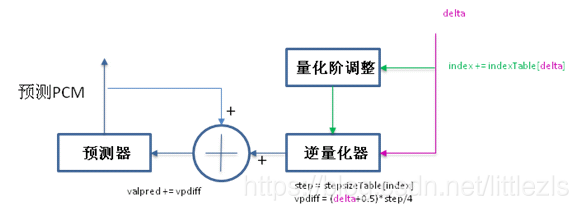淺談adpcm編解碼原理及其程式碼實現
本文講解 0x0011 /* Intel’s DVI ADPCM */的編碼解碼原理。本文原創,轉發請標註littlezls原創。
1. 原始碼
adpcm.h
#ifndef ADPCM_H
#define ADPCM_H
struct adpcm_state
{
int valprev;
int index;
};
extern void adpcm_coder(short *indata, signed char *outdata, int len, struct adpcm_state *state);
extern void adpcm_decoder(signed char adpcm.c
/***********************************************************
Copyright 1992 by Stichting Mathematisch Centrum, Amsterdam, The
Netherlands.
All Rights Reserved
Permission to use, copy, modify, and distribute this software and its
documentation for any purpose and without fee is hereby granted,
provided that the above copyright notice appear in all copies and that
both that copyright notice and this permission notice appear in
supporting documentation, and that the names of Stichting Mathematisch
Centrum or CWI not be used in advertising or publicity pertaining to
distribution of the software without specific, written prior permission.
STICHTING MATHEMATISCH CENTRUM DISCLAIMS ALL WARRANTIES WITH REGARD TO
THIS SOFTWARE, INCLUDING ALL IMPLIED WARRANTIES OF MERCHANTABILITY AND
FITNESS, IN NO EVENT SHALL STICHTING MATHEMATISCH CENTRUM BE LIABLE
FOR ANY SPECIAL, INDIRECT OR CONSEQUENTIAL DAMAGES OR ANY DAMAGES
WHATSOEVER RESULTING FROM LOSS OF USE, DATA OR PROFITS, WHETHER IN AN
ACTION OF CONTRACT, NEGLIGENCE OR OTHER TORTIOUS ACTION, ARISING OUT
OF OR IN CONNECTION WITH THE USE OR PERFORMANCE OF THIS SOFTWARE.
******************************************************************/ 2. adpcm編解碼原理
1.adpcm編碼原理
 編碼步驟:
編碼步驟:
- 求出輸入的pcm資料與預測的pcm資料(第一次為上一個pcm資料)的差值diff;
- 通過差分量化器算出delta(通過index(首次編碼index為0)求出step,通過diff和step求出delta)。delta即為編碼後的資料;
- 通過逆量化器求出vpdiff(通過求出的delta和step算出vpdiff);
- 求出新的預測valpred,即上次預測的valpred+vpdiff;
- 通過預測器(歸一化),求出當前輸入pcm input的預測pcm值,為下一次計算用;
- 量化階調整(通過delta查表及index,計算出新的index值)。為下次計算用;
2.adpcm解碼原理

解碼步驟(其實解碼原理就是編碼的第三到六步):
- 通過逆量化器求出vpdiff(通過儲存的delta和index,求出step,算出vpdiff);
- 求出新的預測valpred,即上次預測的valpred+vpdiff;
- 通過預測器(歸一化),求出當前輸入pcm input的預測pcm值,為下一次計算用。預測的pcm值即為解碼後的資料;
- 量化階調整(通過delta查表及index,計算出新的index值)。為下次計算用;
註釋說明
- 通過編碼和解碼的原理我們可以看出其實第一次編碼的時候已經進行了解碼,即預測的pcm。
- 因為編碼再解碼後輸出的資料已經被量化了。根據計算公式delta = diff*4/step;vpdiff = (delta+0.5)*step/4;考慮到都是整數運算,可以推匯出:pcm資料經過編碼再解碼生成的預測pcm資料,如果預測pcm資料再次編碼所得的資料與第一次編碼所得的資料是相同的。故pcm資料經過一次編碼有損後,不論後面經過幾次解碼再編碼都是資料一樣,音質不會再次損失。即相對於第一次編碼後,以後資料不論多少次編解碼,屬於無損輸出。
3. ADPCM資料存放形式
本部分為adpcm資料存放說明,屬於細節部分,很多程式碼解碼出來有噪音就是因為本部分細節不對,所以需要仔細閱讀。
1. adpcm 資料塊介紹
adpcm資料是一個block一個block存放的,block由block header (block頭) 和data 兩者組成的。其中block header是一個結構,它在單聲道下的定義如下:
Typedef struct
{
short sample0; //block中第一個取樣值(未壓縮)
BYTE index; //上一個block最後一個index,第一個block的index=0;
BYTE reserved; //尚未使用
}MonoBlockHeader;
對於雙聲道,它的blockheader應該包含兩個MonoBlockHeader其定義如下:
typedaf struct
{
MonoBlockHeader leftbher;
MonoBlockHeader rightbher;
}StereoBlockHeader;
在解壓縮時,左右聲道是分開處理的,所以必須有兩個MonoBlockHeader; 有了blockheader的資訊後,就可以不需要知道這個block前面資料而輕鬆地解出本block中的壓縮資料。故adpcm解碼只與本block有關,與其他block無關,可以只單個解任何一個block資料。 block的大小是固定的,可以自定義,每個block含的取樣數nsamples計算如下:
//
#define BLKSIZE 1024
block = BLKSIZE * channels;
//block = BLKSIZE;//ffmpeg
nsamples = (block - 4 * channels) * 8 / (4 * channels) + 1;
例如audition軟體就是採用上面的,單通路block為1024bytes,2041個samples,雙通路block為2048,也是含有2041個sample。 而ffmpeg採用block =1024bytes,即不論單雙通路都為1024bytes,通過公式可以算出單雙通路的samples數分別為2041和1017;
2. 單通路pcm格式:
| byte 0 byte 1 | byte 2 byte 3 | byte 4 byte 5 | byte 6 byte 7 | byte 8 byte 9 | … |
|---|---|---|---|---|---|
| sample0 | sample1 | sample2 | sample3 | sample4 | … |
單通路壓縮為adpcm資料為 4bytes block head + raw data:
| byte 0 byte 1 | byte 2 | byte 3 | byte 4 | byte 5 | byte 6 | byte 7 | byte 8 | byte 9 | … |
|---|---|---|---|---|---|---|---|---|---|
| sample0 | index | reserved | data0 | data1 | data2 | data3 | data4 | data5 | … |
其中sample1編碼後存data0低4位,sample2編碼後存data0高四位...
3. 雙通路pcm格式:
| byte 0 byte 1 | byte 2 byte 3 | byte 4 byte 5 | byte 6 byte 7 | byte 8 byte 9 | … |
|---|---|---|---|---|---|
| sampleL0 | sampleR0 | sampleL1 | sampleR1 | sampleL2 | … |
雙通路壓縮為adpcm資料為 4bytes block L head + 4bytes block R head + 4bytes raw L data + 4bytes raw R data…: adpcm雙通路block head:
| byte 0 byte 1 | byte 2 | byte 3 | byte 4 byte 5 | byte 6 | byte 7 |
|---|---|---|---|---|---|
| sample0L | indexL | reservedL | sample0R | indexR | reservedR |
接著雙通路raw壓縮資料4byte L, 4byte R …:
| byte8 | byte9 | byte10 | byte11 | byte12 | byte13 | byte14 | byte15 | byte16 | byte17 | byte17 | … |
|---|---|---|---|---|---|---|---|---|---|---|---|
| data0L | data1L | data2L | data3L | data0R | data1R | data2R | data3R | data4L | data5L | data6L | … |
